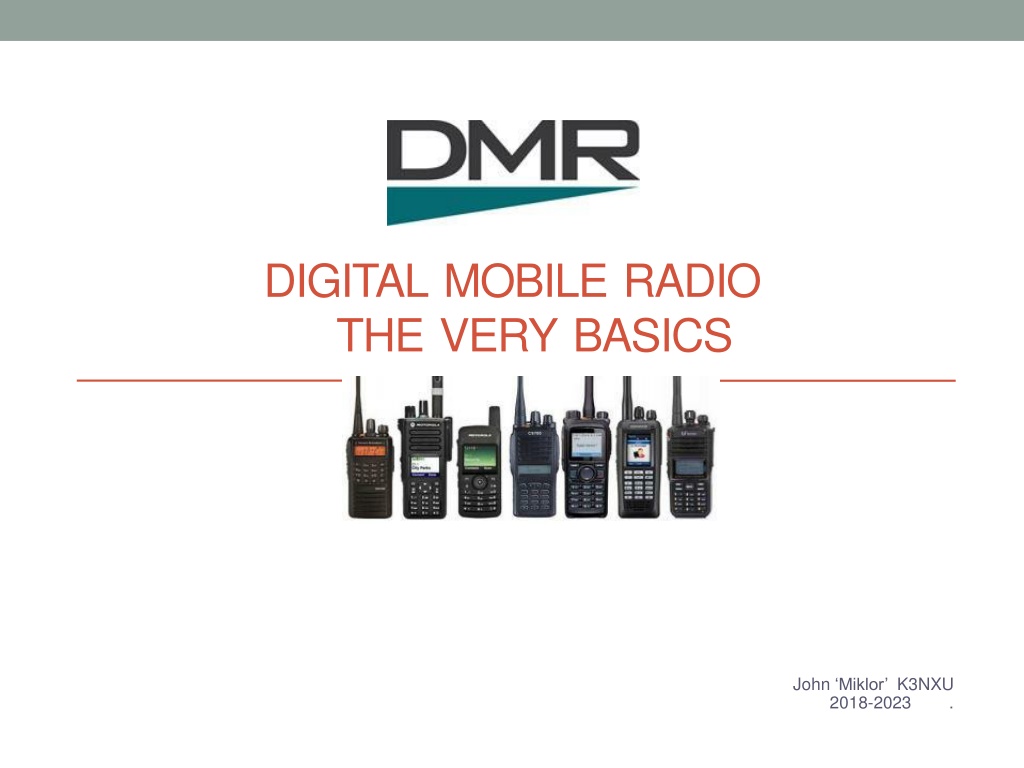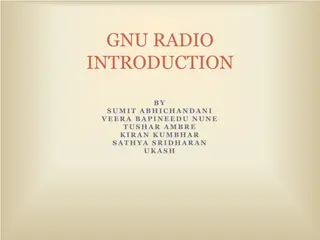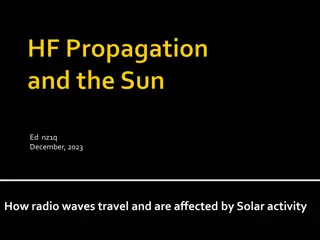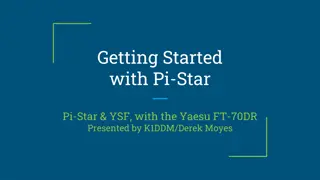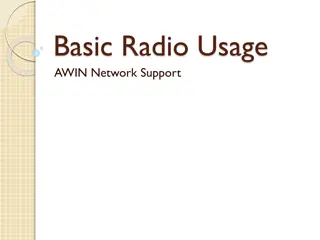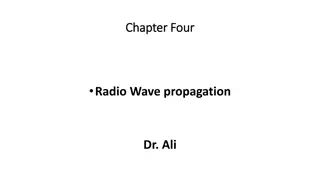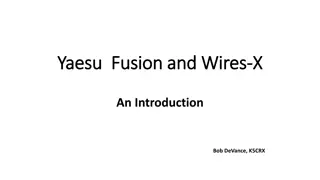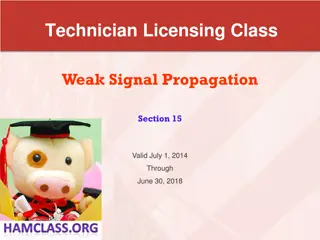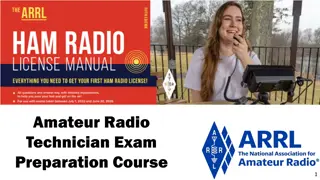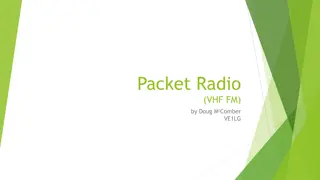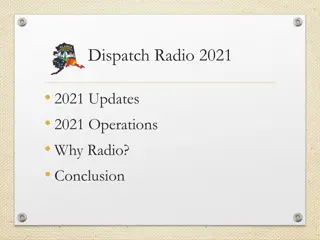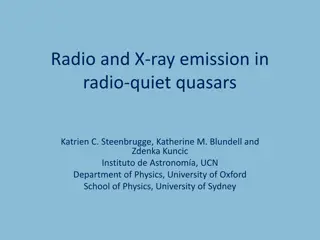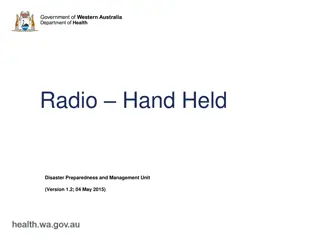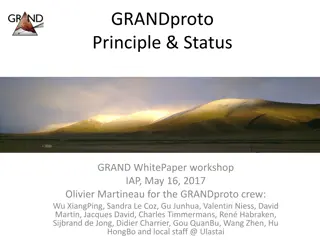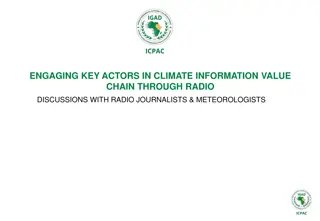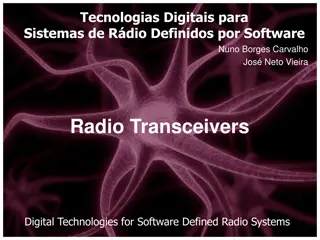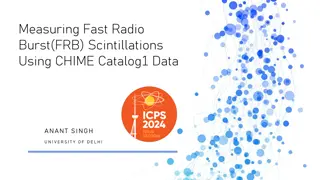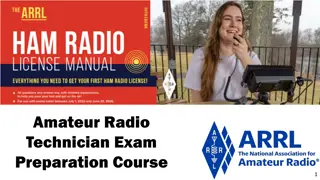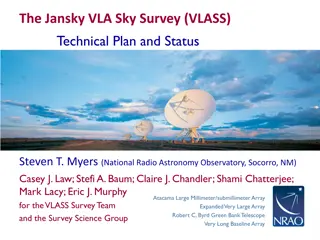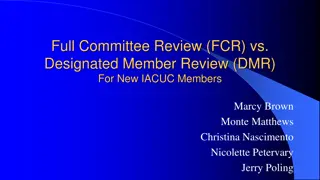Digital Mobile Radio (DMR) Basics
Explore the fundamentals of Digital Mobile Radio (DMR) technology including its brief history, audio quality differences, spectrum efficiency with time slots, talk groups diversity, and more. Discover how DMR provides clear communication, improved bandwidth efficiency, and a wide range of talk group options for various interests and purposes.
Download Presentation

Please find below an Image/Link to download the presentation.
The content on the website is provided AS IS for your information and personal use only. It may not be sold, licensed, or shared on other websites without obtaining consent from the author.If you encounter any issues during the download, it is possible that the publisher has removed the file from their server.
You are allowed to download the files provided on this website for personal or commercial use, subject to the condition that they are used lawfully. All files are the property of their respective owners.
The content on the website is provided AS IS for your information and personal use only. It may not be sold, licensed, or shared on other websites without obtaining consent from the author.
E N D
Presentation Transcript
DIGITAL MOBILE RADIO THE VERY BASICS John Miklor K3NXU 2018-2023 .
The DMR Difference The areas covered here will be: Brief History Audio Quality Difference Spectrum Efficiency The Local and Worldwide Network Repeaters vs. Hotspots Code Plugs Basics
Brief History DMR was developed in Europe by ETSI, European Telecomm Standards Institute and was adopted as Commercial Standard 20 years ago. Initially, commercial business equipment was the only source of DMR handhelds and mobiles. Several ham radio vendors have since entered the DMR market with radios that are a bit more affordable and designed more for ham radio use.
Audio Quality Digital vs Analog Where an analog signal will lose quality and readability as the signal strength is decreased, a digitally processed signal will remain clear until the signal is lost.
Spectrum Efficiency (Time Slots) Where the bandwidth of an Analog FM signal is 25.0 kHz, the DMR (TDMA) bandwidth is only 12.5 kHz. Not only does it occupy half of the required bandwidth, but it has the ability to transmit two separate conversations at the same time. This is accomplished by digitally splitting a transmitted signal into alternating 30 millisecond slices referred to as Time Slots. TDMA = Time-Division Multiple Access
Spectrum Efficiency 30ms Time Slices Arepeater interweaves the incoming signals based on the Time Slot requested.
Time Slots Much like a Duplex House, two totally separate families can reside in one structure. These divisions are referred to as Time Slots. TS1 TS2 Each house has its own set of rooms. These are referred to as Talk Groups (TG).
Talk Groups There are currently over 1500 Talk Groups, ranging from: - Local Repeater Only - Local Network Repeaters - Statewide Groups - Regional Groups - Country Specific Groups - Worldwide Groups - Special Interest Groups Examples of these groups include: - Public Safety - Outdoor Adventure - JOTA (Scouting) - EmComm - Handi-Hams - etc.
Talk Groups Not all repeaters carry all Talk Groups (TG) depending on their network connection. The repeater s owner assigns the TG and TS structure most beneficial for your area. This is to permit the most activity with the least amount of interference. A typical configuration might be: TG 2 9 310, 311 3100 3142 3124 3172 Time Slot 2 2 2 1 1 1 1 Local 2 Local 9 TAC 310, 311 Nationwide PA State MD State NE Reg l Local Cluster of Repeaters Local Repeater Only Secondary Chat Groups National Calling Channel PA Statewide MD Statewide Northeast Regional
Full Time vs Part Time (Repeater) A Full Time (FT) group is one that is always available for monitoring. If the TG becomes active, you will hear the traffic immediately. These are normally Local and State groups. A Push-to-Talk TG is one that requires activation and only stays active for a predefined amount of time. These would be high traffic groups, such as Nationwide, Worldwide, etc. The TG remains active for a given amount of time after your last PTT. It will then release the TS for other potential users. Only one TG can be active for each TS. TG 2 9 310 311, 312 3100 3142 3124 Time Slot 2 2 2 2 1 1 1 Local 2 Local 9 TAC 310 TAC 311, 312 Nationwide PA State MD State Local Cluster of Repeaters Local Repeater Only Secondary Groups Chat Groups National Calling Channel PA Statewide MD State FT FT PTT ( 5 min) PTT (15 min) PTT ( 5 min) FT PTT (15 min)
Sample Repeater Configuration Important to remember. The configuration will vary from one repeater to another. Contact your local club or repeater owner to determine the exact configuration.
Local / Worldwide Network A sample repeater is shown here. Depending on its location, a stand alone repeater can cover a local area of several miles, but when connected to a DMR network server, it can provide worldwide access. C:\Users\Johns-PC\Documents\My Web Sites\Miklor Web Files\--- DMR\images\DMR-c-Bridge.jpg Note: Repeater cost and operation can be quite expensive. Please support your local club or repeater owner. C:\Users\JohnL\OneDrive\Documents\My Web Sites\Miklor Web Files\--- DMR\images\BridgeCom-Logo.jpg
The World Wide Network Latency An example of the complexity of the network is shown here. Although the internet is fast, it is not instant. Your audio is digitally processed in your handheld, forwarded to the repeater, then to a regional server connected to a series of worldwide servers where it is distributed. The process is then reversed before it is delivered to the receiving station. This is referred to as latency, a delay of your signal getting to the other end by as much as 2 seconds. For this reason, it is advisable to pause for two or three seconds before making a return transmission to give a breaking station a chance to enter.
Push-to-Talk Analog vs Digital Because of the number of TGs available, it s very possible someone might be using a TG other than the one you are monitoring. If this occurs, your signal could interfere with theirs. This is avoided by the way DMR handles the PTT function. With Analog, pressing the PTT keys the transmitter and you re ready to go. Not so on DMR. When the PTT is pressed, a signal is sent to the repeater which checks to see if the Time Slot is available. If it is, a data stream is sent back to the radio giving you the All Clear, sometimes generating a beep tone. This occurs in just under a second. It is highly recommend that the BCLO (Busy Channel Lock Out) function is enabled. This prevents a station from transmitting on a Time Slot if it is currently active. Another indicator that the TG is in use is an activity light on the handheld. If the LED is lit, the TS is in use. When pressing the PTT, wait 1 or 2 seconds before speaking.
Busy Repeater Channel / Time Slot You may see the Channel Busy indicator lit, but not hearing a conversation. This is caused by someone activating or using a repeater Talkgroup other than the one you are monitoring. Digital Monitor (DMR) Your DMR radio may have a programmable key function labeled Digi Monitor or Promiscuous mode. This open allows you to monitor all activity on one or both time slots regardless of the Talkgroup in use. This is a monitoring function only. Monitor Mode (Analog) This is an analog function which opens the squelch allowing you to listen to activity on that frequency. The Monitor and Digital monitor modes are not interchangeable.
Networks You may hear reference to various networks, such as DMR-MARC, Brandmeister, TGIF, and others. Although these are independent networks, some do share Talk Groups between them. Much like two pine trees planted side by side, as time evolves, more of the branches (Talk Groups) become common to both. Some examples are shown on the next page. Also, it should be noted that not all networks support the same features, such as GPS and APRS.
Shared Network TG Activity TAC 310, 311, 312 313 > 319 State Groups Regional Groups Nationwide 3100 shared x shared x shared TAC 310, 311, 312 313 > 319 State Groups n/a Nationwide 3100 Some examples of TG sharing are shown above. There are 10 TAC channels. While TAC 310, 311 and 312 are common to both networks, 313-319 are not. US State Groups are common to both networks, while Regional Groups are not.
Several Networks Available There are several networks available for ham radio use. It is recommended to investigate not only the available Talk Groups, but also the Location of the servers before making your selection. Talk Groups - Not all servers share the same Groups. BrandMeister TGs TGIF TGs The location of the server is also important. The further you are from a server, the longer the delay, or Latency. For example, if you are in the US, the TGIF network and BrandMeister are excellent choices.
Repeater vs. Hotspot There are two main pieces of equipment used to access the DMR network. One is a Repeater which is normally located at a high elevation with wide area coverage. The repeater is then linked to the internet allowing it to access one or more DMR network servers. Note: Not all repeaters share the same Talk Groups. This is determined by the repeater s owner. The other is known as a Hot Spot. These were developed for local range access to a network when no repeater is available. These low power devices receive a users digital signal and passes it to a DMR network via the internet. C:\Users\JohnL\OneDrive\Desktop\- Temp II\HotSpots.jpg
Activity Levels (DMR-MARC & BrandMeister) This varies by Talkgroup (TG). Local groups usually carry the lowest level of activity, where State and Regional activity is a bit heavier. The bulk of the activity can be found on the National and World Wide TGs TG 2 9 Activity Low Low Local 2 Local 9 Local Cluster of Repeaters Main Repeater Only PA State MD State NE Reg l Mid Atlantic TAC 310>312 PA Statewide MD Statewide Northeast Regional Mid Atlantic Chat Groups 3142 3124 3172 3173 310>312 Med Med Med Med Med Nationwide National US Calling Channel 3100 High
Important Operating Note TG-3100 Nationwide - TG 3100 was created as a shared Nationwide Calling Channel. If you are using a Hotspot, once activated, the group remains Static and will remain continuously active until another TG is selected. Note: Due to the high activity of 3100, Repeaters may require a PTT (kerchunk) once every 10 minutes to reactivate. This frees up repeater access to other users. - TG 310, 311, and 312 are secondary TAC channels. They are set up as PTT groups requiring a PTT (kerchunk) once every 10 minutes to reactivate. - TG 3100 is for establishing an initial contact. If the conversation continues for more than 3 or 4 minutes, stations should move to one of the three TAC channels to clear 3100 as a courtesy to those monitoring. Note: Also remember, there are over 1,500 available Talk Groups. If the activity is spread out, there is plenty room for everyone to enjoy the DMR experience.
Repeater and Network Operating Notes 3 second pause before PTT This allows for network latency as well as a courtesy pause for those wanting to enter the conversation. 1 second pause after PTT This is required for your radio to sync with the repeater and network Time Slot in use This is usually shown by an indicator light or a time slot busy tone on your radio. Talkgroup in use You may not immediately hear an active Talkgroup. When switching to a different TG, your radio may need to sync to a conversation already in progress. Announcing your presence Announce both your Call Sign and Talkgroup. This will allow someone who is scanning to identify your Talkgroup so they can answer your call.
Repeater and Network Operating Notes Brandmeister Network User Blocked (521) *** When using the Brandmeister Network, your server access will be blocked for one hour if the following conditions are met: - 5 transmissions of less then 2 seconds within 1 minute. This is part of the network loop prevention. After one hour, access to that server will automatically be restored.
Network Activity Monitoring The following links allow you to see the network activity Real Time. http://cbridge1.wr3irs.com:42420/CallWatch http://cbridge2.wr3irs.com:42420/CallWatch Netwatch Hoseline (BrandMeister) https://hose.brandmeister.network/ Allows you to listen Live to activity. K3NXU.com (DMR Section) www.K3NXU.com Miklor.com www.miklor.com/DMR/
References Miklor DMR Section The Amateur Radio Guide to DMR Applying for a DMR user ID
Code Plug (CP) Don t let the name scare you. A Code Plug (CP) is nothing more than the data file that is loaded to your DMR radio that sets the operating parameters. (Frequency, power, etc.) You will also see reference to the CPS. This is simply the Code Plug Software. Code plugs consist of 3 main parts (1) Contact List (Talk Groups to be assigned) (2) Channel Information (3) Zones (Channel groups or clusters) Let take a look at the three pieces and how they tie together.
Code Plug The Contact List Before you start the trip, you need to know where you want to go. This is done by creating a Contact List. This is where the desired Talkgroup information can be found. There are 2 main elements. - Talkgroup Name Names you create for the desired DMR groups. - Talkgroup Number This is the number assigned to each specific group. The Call Type will always be Group Call
Code Plug The Channel Information This looks more complex than it actually is Mode Frequency Color Code Bandwidth Time Slot Tx Contact Rx Contact Power Tx Criteria Scan List Digital The repeater s Rx / Tx frequency 1 (The digital equivalent of CTCSS, normally 1) 12.5 kHz 1 or 2 (Whatever is assigned to that TG) Talkgroup selected from the Contact List None will default to the Tx Contact High or Low Channel Free , Color Code, Always Optional
Code Plug Channel Creation Hints A separate channel needs to be created for every TG desired. Not all repeaters carry every TG (over 1500 possibilities). This is at the discretion of the repeater owner. Start your initial channel list with only 5-10 channels. Until you become comfortable with code plugs, start small. It s much easier to correct 5 channels than 150. There is no Master CP. It s is recommended to start with reviewing a Sample CP. From there you can get a feel for how one is assembled.
Code Plug The Zone The Zone is where you group channels together by category. For instance, if you want the channels for a particular repeater in one group, you would assign them to their own Zone (channel bank). They can be grouped by: - Repeater - Location - Activity - Analog Repeaters - Simplex - etc. You can mix and match. The choice is yours.
Code Plug The Scan List After the channels are set up, consider using Scan Lists. This is where you create a group of channels that you would like to Scan when selected. Give the Scan List a name describing the included channels. The list can now be assigned to one or more channels.
Code Plug The Scan List You can now assign this list to a channel in the drop down labeled Scan List. When that channel is selected, using the programmable key assigned to Scan will start the scanning function for the specified group.
Code Plug Samples Code Plugs are a bit intimidating at first. To assist with this, examining a sample code plug for your radio is recommended. Some sources of samples are: - Miklor There is a Sample Code Plug section. - Facebook Find a group for your specific radio. Check the Files section. - Radio Club Ask a member with the same model. - Google Search Remember, every code plug is different. Use these as a guide and customize to your desired setup.
Summary First and foremost, never forget that this is a hobby. Individuals have invested their time and money in support of this network. Repeaters, Servers and Networks require maintenance. Support your local club whenever possible. If a network or online software develops a temporary issue, be patient. These volunteers have families and jobs which is their first priority. Take the time to say Thank You.
Conclusion I hope I was able to answer a few of your entry level questions. The purpose of this presentation was to help you feel a bit more comfortable with some of the basics and terminology used in the DMR world. Don t expect to become a master at this in a few days. Experiment by creating your own code plugs. Have fun and I ll see you on DMR. John Miklor K3NXU Miklor.com/DMR Support Miklor
